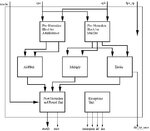psurya1994
Member level 5

- Joined
- Jun 29, 2012
- Messages
- 86
- Helped
- 3
- Reputation
- 6
- Reaction score
- 3
- Trophy points
- 1,288
- Activity points
- 1,807
Is it possible to implement a Floating Point Unit (FPU) (Single Precision IEEE 754 format) on an FPGA which can do all addition, subtraction, multiplication and division? If yes, which algorithms would be good for multiplication and division?
I'm using Xilinx IDE.
I'm using Xilinx IDE.


